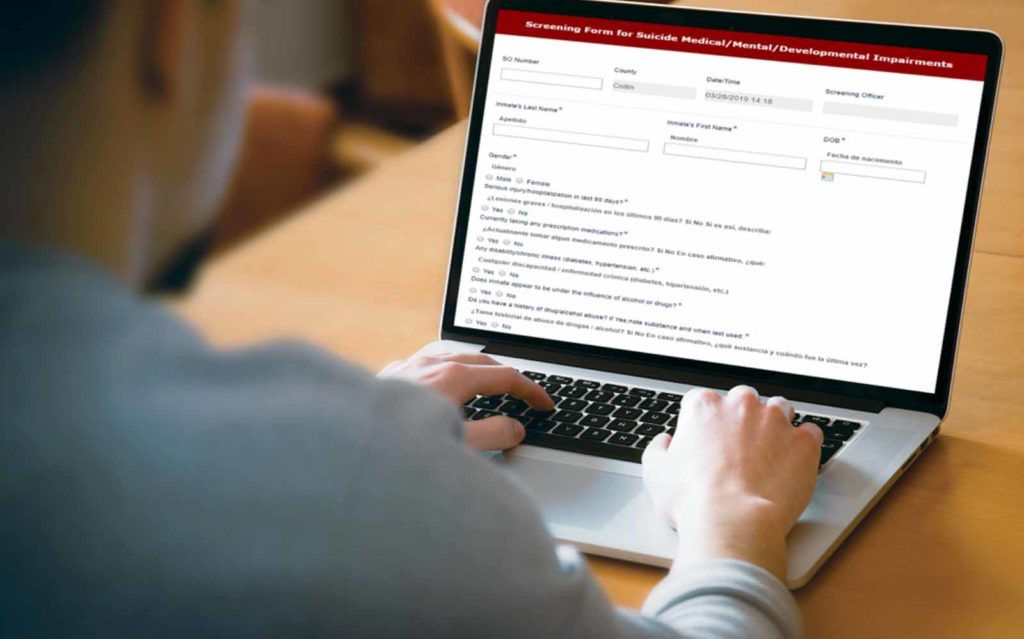It’s a pleasure to introduce the Records Management Officer, L’Cena Parsons, and Senior Applications Manager, Tim Nolan, of Collin County, Texas.
Collin County is using Laserfiche Forms to change lives; their Early Identification of Mental Illness Screening workflow is one of the most critical processes in the county. This innovative and transformative use of Laserfiche, won them the 2019 Laserfiche Run Smarter Social Impact Award.
About Collin County, Texas
Collin County, TX is one of the fastest growing counties in Texas and the nation. As part of the Dallas/Fort Worth metroplex, including cities such as Plano, Frisco and McKinney, Collin County’s population exceeds 1,000,000.
The Problem
Describe how Laserfiche transformed the way your organization works.
Over the past 5 years, the county’s utilization of Laserfiche increased drastically. Since 2014, we converted over 19,000 boxes of physical documents within our records department and trained various departments to add documents directly into Laserfiche without initially storing them physically. Since 2014, our physical storage capacity at our records management warehouse went from 101 percent to 21 percent and we have added approximately 40 million images to Laserfiche.
Please share specific business process management improvements that your organization experienced.
In order to serve an expanding population, our county has been shifting to digitizing and automating many business processes in multiple departments. One recently automated process that has a huge impact is the Early Identification of Mental Illness (EIMI) process in our corrections system.
Every person who is booked into the county jail must go through a mental health screening and certain inmates who complete the screening end up on a mental health watch list. Each person must go through the entire process within 12 hours of booking, otherwise, the county jail may incur violations.
Previously, the EIMI process was conducted using emails and paper documents, resulting in lost documentation and failed audits. The county decided to streamline it with Laserfiche Forms and Workflow.
When a person is booked, the booking staff fills out an extensive electronic form that contains yes or no questions for the person to evaluate their state of mental health. Any ‘yes’ question is considered a red flag.
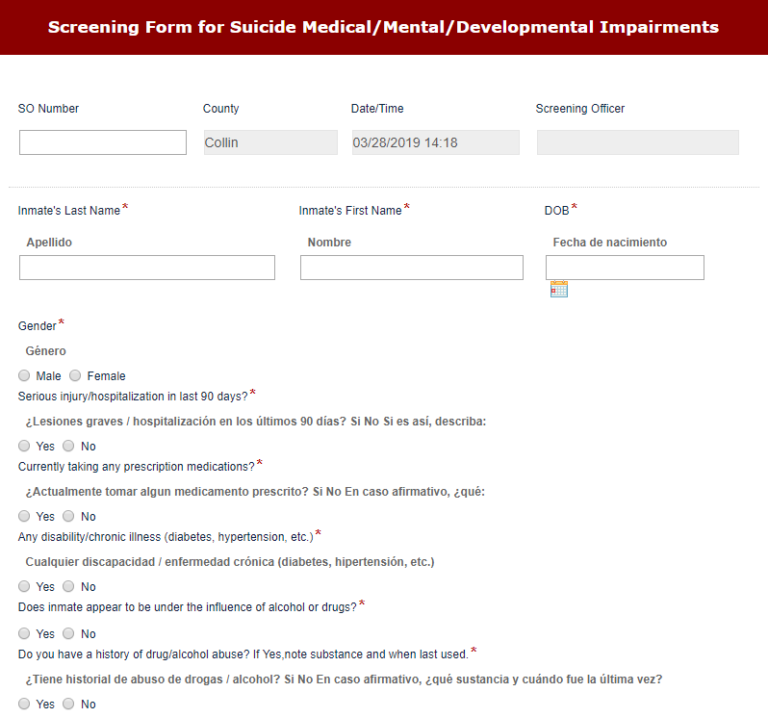
Once the form is submitted, it is added to a queue for a medical team to review. If the medical team does not finish the review of the form within an hour, then the supervisor is notified to sign off on the form instead. In order to simplify medical and supervisor review, any question that has a ‘yes’ answer is highlighted in blue.Once the form is submitted, it is added to a queue for a medical team to review. If the medical team does not finish the review of the form within an hour, then the supervisor is notified to sign off on the form instead. In order to simplify medical and supervisor review, any question that has a ‘yes’ answer is highlighted in blue.

In order to improve review, all questions with an answer of Yes are highlighted in blue.
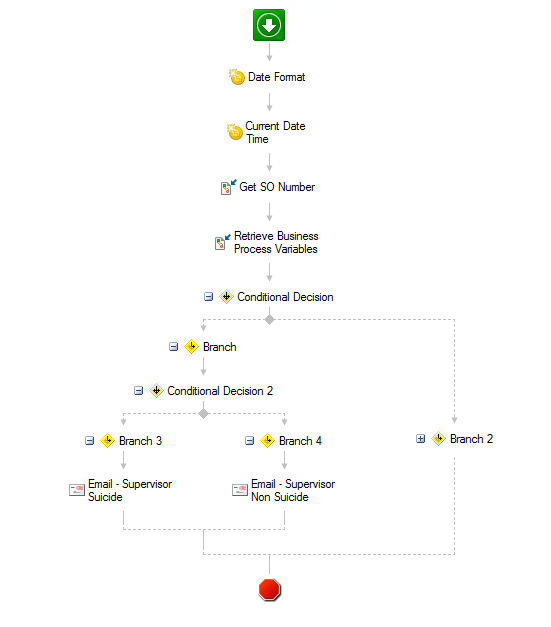
This workflow notifies the supervisor if the medical team does not review the EIMI form within an hour. Once the supervisor approves the form, Laserfiche Workflow generates a report from the data and emails it to the magistrate. If no one signs off within eight hours, the magistrate is also notified that the review is unfinished. The email that is sent to the magistrate contains a link to the Laserfiche folder where the EIMI form and other relevant documents are stored.

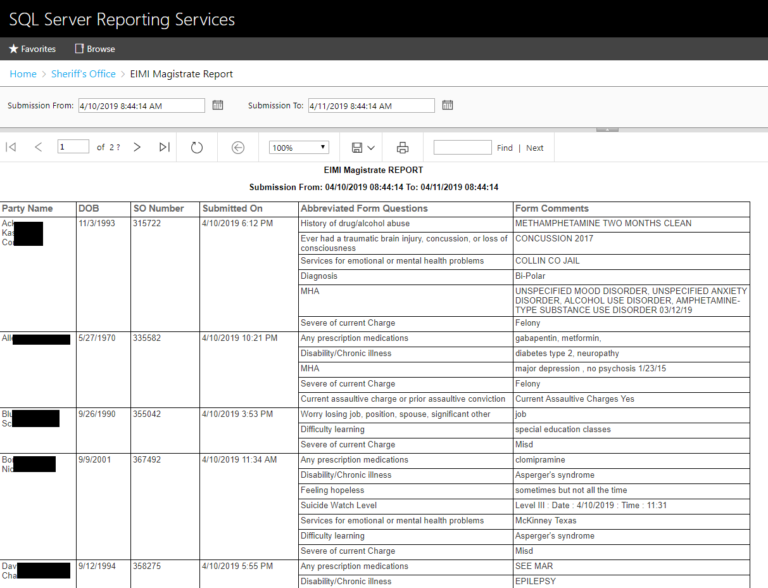
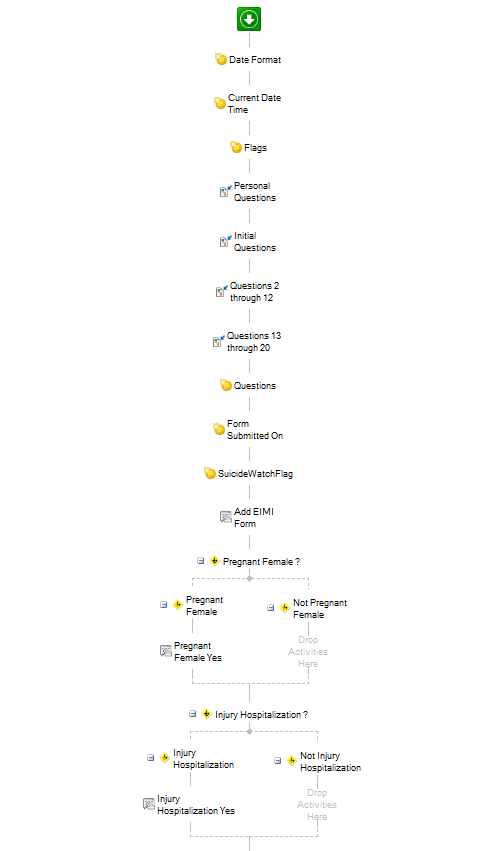
All screening forms are stored in the records management section of the Laserfiche repository and retained for one year.
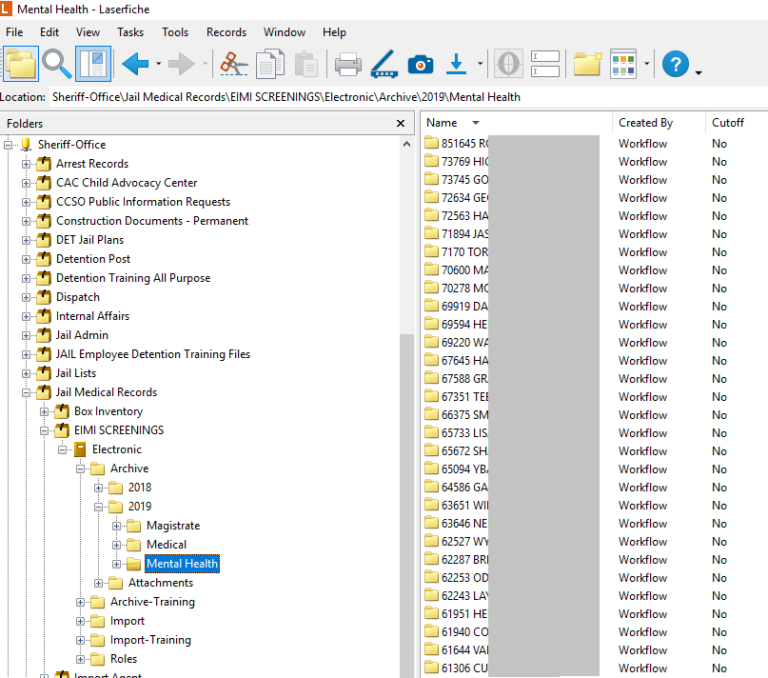
Audits are so much less painful since the full history of each screening is recorded and time stamped along with the form. Each form has its review and approval history included on the first page, which simplifies audits.
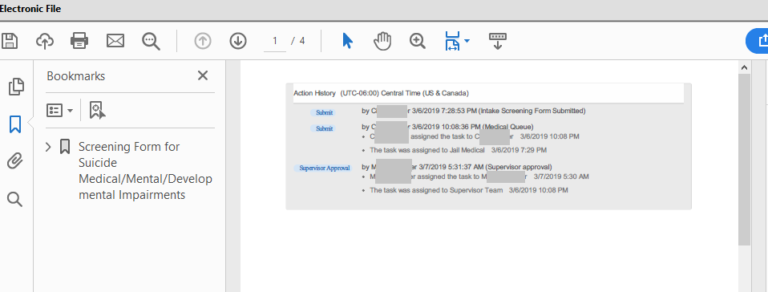
This is what the entire process looks like in the Laserfiche Forms process model:
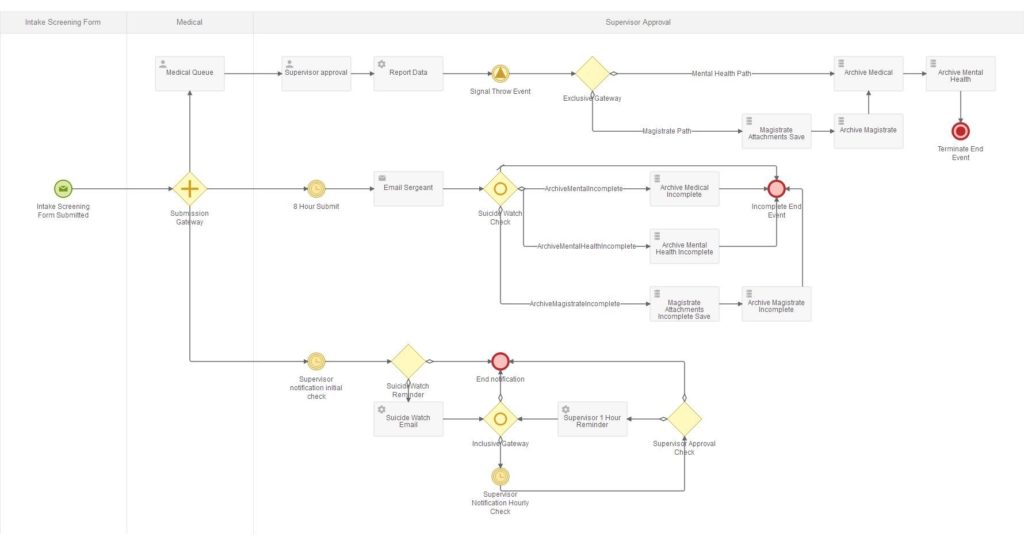
This EIMI form is one of the most critical processes in the county. This EIMI process runs 24 hours a day, 7 days a week. Timers and notifications enable screenings to take no more than 12 hours to complete from start to finish, ensuring that the county is following rules and regulations.
The Solution
Describe how Laserfiche’s features and functionality play a significant role within your organization.
Laserfiche’s capabilities are far beyond an “archival” system. It is no longer just a product we use for converting paper files to electronic images, although this aspect of the system is certainly a huge benefit. With the records management features, we are able to better monitor what goes into Laserfiche, rights and roles to access this data, apply cut offs where applicable and manage the life cycle of the documents. With Laserfiche Import Agent, we have been able to streamline processes for departments that do not necessarily have to access Laserfiche very often but do utilize it to maintain retention of their documents. With Laserfiche Connector we can easily integrate with another system used by the Tax Office and have ideas as well for future work other departments. The addition of Laserfiche Forms has been a game changer for us, and we see no end to the manual processes we can automate and improve upon in the future.
What specific savings (time and cost) organization-wide do you link directly to using Laserfiche? How do you quantify your organization’s return on investment?
It’s hard to put in exact numbers the time and money saved throughout the county with the utilization of Laserfiche, however, without a doubt we have heard from various departments over the years how much less time it has taken to retrieve documents. What used to take hours or even days to go off site to look for old paper documents or many instances, a request had to be officially documented to have someone retrieve this information and then arrange to have it delivered across town. Now in most cases, these images have been converted electronically for their own easy retrieval.
By automating the Early Identification of Mental Illness (EIMI) form, we were able to meet state mandated deadlines, which previously, failure to do so not only jeopardized lives, but also incurred penalties by the stat of procedures were not followed. The integration with the RT Lawrence’s property tax coupon and check-scanning saves 10 days in processing time and earned over $1 Million in interest, annually. We used Laserfiche Connector to save the county $60,000 in third-party integration fees with our Property Tax system.
Another example of a return on investment is the ability to know that these records are being retained for the full retention periods and are always kept secure. Prior to Laserfiche, the only security was a box lid and you were at the mercy of no backups of paper records. Specifically, regarding one of our larges departments, the District Attorney’s office – prior to utilizing Laserfiche, we were over capacity at our records warehouse and had to put a freeze on accepting more boxes in hallways and offices to the point that they could not find files or add needed staff. This issue was eliminated within one year after our Records Center began using Laserfiche to convert paper to electronic records.
Which applications did you integrate with Laserfiche? Tell us how they work.
With the addition of Laserfiche Connector we have been able to integrate Laserfiche with the RTL Property Tax system in order to streamline the Tax office’s business process, allowing for more efficient and quicker retrieval of images and data they need.
The property tax check-scanning, and processing automation continues to pay large dividends annually. We developed an online payment Laserfiche Form for cremation permits that integrated with our credit card merchant. We didn’t have to look far when developing our Public Notices and Foreclosure applications to realize that Laserfiche was the ideal image repository for these public documents.
The Future
What plans do you have for Laserfiche within your organization?
Technology is changing and we are planning to change along with it and Laserfiche will be a huge part of that! We plan to continue to produce more Laserfiche forms to automate business processes throughout the county. Once we have worked with all the departments, we plan to go back and talk to all of them again to see how we can continue to improve those areas. We also have historical TAX books to digitize and make available to the public. We attend Laserfiche Empower conference each year to see what’s new and evaluate if we can utilize new feature in the future.
What advice would you give someone just starting out with Laserfiche?
- Take time at the beginning to make sure you set up your repositories and record series correctly. Utilizing the records management features and keeping them up to date will be extremely helpful in maintaining your records management practices accurately and with ease in the future.
- Keep up with the new features that Laserfiche rolls out as well as the latest versions that are available. There are always looking for ways to improve our industries.
- Attend the Laserfiche Empower conference! You will learn so much from your peers and their experiences. It allows you to be on the lookout for ways to better your business practices.
- Be willing to go beyond the conception that “we’ve always done it this way.” Be open to change!

